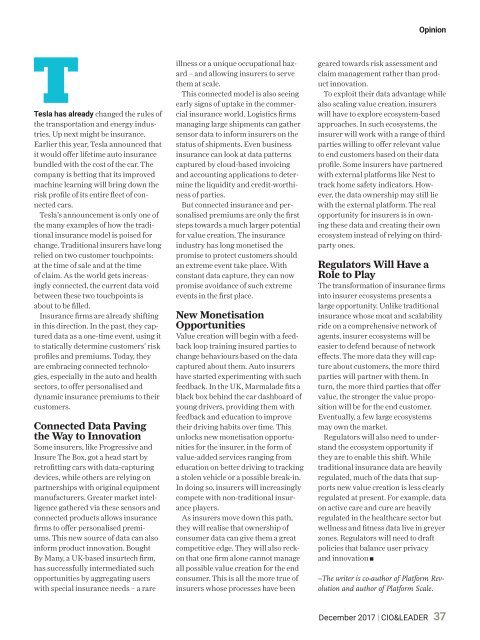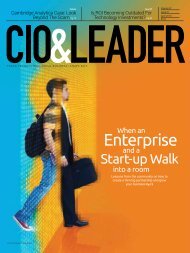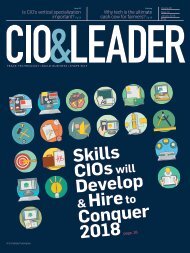C&L_December 2017 (1)
Create successful ePaper yourself
Turn your PDF publications into a flip-book with our unique Google optimized e-Paper software.
Opinion<br />
TTesla<br />
has already changed the rules of<br />
the transportation and energy industries.<br />
Up next might be insurance.<br />
Earlier this year, Tesla announced that<br />
it would offer lifetime auto insurance<br />
bundled with the cost of the car. The<br />
company is betting that its improved<br />
machine learning will bring down the<br />
risk profile of its entire fleet of connected<br />
cars.<br />
Tesla’s announcement is only one of<br />
the many ex<strong>amp</strong>les of how the traditional<br />
insurance model is poised for<br />
change. Traditional insurers have long<br />
relied on two customer touchpoints:<br />
at the time of sale and at the time<br />
of claim. As the world gets increasingly<br />
connected, the current data void<br />
between these two touchpoints is<br />
about to be filled.<br />
Insurance firms are already shifting<br />
in this direction. In the past, they captured<br />
data as a one-time event, using it<br />
to statically determine customers’ risk<br />
profiles and premiums. Today, they<br />
are embracing connected technologies,<br />
especially in the auto and health<br />
sectors, to offer personalised and<br />
dynamic insurance premiums to their<br />
customers.<br />
Connected Data Paving<br />
the Way to Innovation<br />
Some insurers, like Progressive and<br />
Insure The Box, got a head start by<br />
retrofitting cars with data-capturing<br />
devices, while others are relying on<br />
partnerships with original equipment<br />
manufacturers. Greater market intelligence<br />
gathered via these sensors and<br />
connected products allows insurance<br />
firms to offer personalised premiums.<br />
This new source of data can also<br />
inform product innovation. Bought<br />
By Many, a UK-based insurtech firm,<br />
has successfully intermediated such<br />
opportunities by aggregating users<br />
with special insurance needs – a rare<br />
illness or a unique occupational hazard<br />
– and allowing insurers to serve<br />
them at scale.<br />
This connected model is also seeing<br />
early signs of uptake in the commercial<br />
insurance world. Logistics firms<br />
managing large shipments can gather<br />
sensor data to inform insurers on the<br />
status of shipments. Even business<br />
insurance can look at data patterns<br />
captured by cloud-based invoicing<br />
and accounting applications to determine<br />
the liquidity and credit-worthiness<br />
of parties.<br />
But connected insurance and personalised<br />
premiums are only the first<br />
steps towards a much larger potential<br />
for value creation. The insurance<br />
industry has long monetised the<br />
promise to protect customers should<br />
an extreme event take place. With<br />
constant data capture, they can now<br />
promise avoidance of such extreme<br />
events in the first place.<br />
New Monetisation<br />
Opportunities<br />
Value creation will begin with a feedback<br />
loop training insured parties to<br />
change behaviours based on the data<br />
captured about them. Auto insurers<br />
have started experimenting with such<br />
feedback. In the UK, Marmalade fits a<br />
black box behind the car dashboard of<br />
young drivers, providing them with<br />
feedback and education to improve<br />
their driving habits over time. This<br />
unlocks new monetisation opportunities<br />
for the insurer, in the form of<br />
value-added services ranging from<br />
education on better driving to tracking<br />
a stolen vehicle or a possible break-in.<br />
In doing so, insurers will increasingly<br />
compete with non-traditional insurance<br />
players.<br />
As insurers move down this path,<br />
they will realise that ownership of<br />
consumer data can give them a great<br />
competitive edge. They will also reckon<br />
that one firm alone cannot manage<br />
all possible value creation for the end<br />
consumer. This is all the more true of<br />
insurers whose processes have been<br />
geared towards risk assessment and<br />
claim management rather than product<br />
innovation.<br />
To exploit their data advantage while<br />
also scaling value creation, insurers<br />
will have to explore ecosystem-based<br />
approaches. In such ecosystems, the<br />
insurer will work with a range of third<br />
parties willing to offer relevant value<br />
to end customers based on their data<br />
profile. Some insurers have partnered<br />
with external platforms like Nest to<br />
track home safety indicators. However,<br />
the data ownership may still lie<br />
with the external platform. The real<br />
opportunity for insurers is in owning<br />
these data and creating their own<br />
ecosystem instead of relying on thirdparty<br />
ones.<br />
Regulators Will Have a<br />
Role to Play<br />
The transformation of insurance firms<br />
into insurer ecosystems presents a<br />
large opportunity. Unlike traditional<br />
insurance whose moat and scalability<br />
ride on a comprehensive network of<br />
agents, insurer ecosystems will be<br />
easier to defend because of network<br />
effects. The more data they will capture<br />
about customers, the more third<br />
parties will partner with them. In<br />
turn, the more third parties that offer<br />
value, the stronger the value proposition<br />
will be for the end customer.<br />
Eventually, a few large ecosystems<br />
may own the market.<br />
Regulators will also need to understand<br />
the ecosystem opportunity if<br />
they are to enable this shift. While<br />
traditional insurance data are heavily<br />
regulated, much of the data that supports<br />
new value creation is less clearly<br />
regulated at present. For ex<strong>amp</strong>le, data<br />
on active care and cure are heavily<br />
regulated in the healthcare sector but<br />
wellness and fitness data live in greyer<br />
zones. Regulators will need to draft<br />
policies that balance user privacy<br />
and innovation<br />
–The writer is co-author of Platform Revolution<br />
and author of Platform Scale.<br />
<strong>December</strong> <strong>2017</strong> | CIO&LEADER<br />
37














